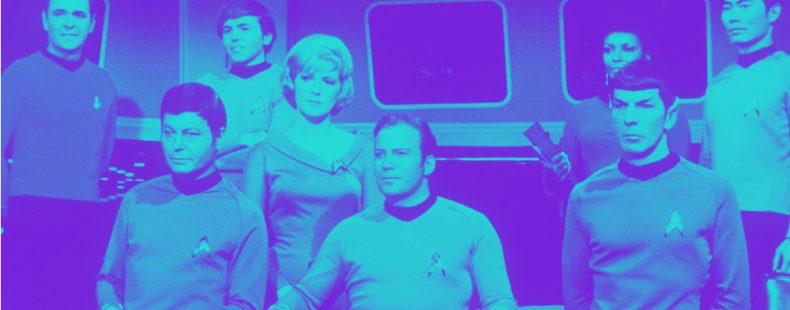Star Trek is one of the most beloved science fiction television franchises to ever air. Debuting in 1966 with Star Trek: The Original Series, this long-running franchise is about the crew of a starship (spaceship), the USS Enterprise, as it explores the deepest depths of outer space. Along the way, the crew meet new life forms, get into all kinds of hijinks, and battle for their lives. The show is particularly known for the way it implicitly and explicitly addresses issues of race; in fact, the original series featured one of the first multiracial casts on American television.
Over time, the Star Trek franchise—which now includes movies, books, comics, and even an animated series—has had an enormous influence on popular culture. Terms and expressions from the show, like live long and prosper, have become part of the general lexicon, even for people who couldn’t pick Captain Kirk out of a lineup (hint: it’s the guy who looks like William Shatner).
There are dozens of terms that Star Trek has contributed to the English language. We’ve picked out just a handful of expressions the show created or popularized to highlight their meanings and origin stories. Read on if you dare.
To boldly go where no man has gone before
It sounds like something JFK would say, but it was actually popularized by Star Trek. “Where No Man Has Gone Before” is the name of the second Star Trek pilot, which eventually became the third episode of the first season of the original series—got that straight? It was written by Samuel A. Peeples, a prolific television writer best known for his Westerns.
The expression itself made its way into the voiceover by Captain James Tiberius Kirk (played by William Shatner) that opened every episode of the original run of show:
Space: the final frontier. These are the voyages of the starship Enterprise. Its five-year mission: to explore strange new worlds. To seek out new life and new civilizations. To boldly go where no man has gone before.
In the series Star Trek: The Next Generation (1987–1994), the language was changed to no one has gone before to be more gender neutral.
The expression itself has gone far from its origins and become a reference point for memes and snowclones in its own right. For instance, the phrase “to boldly go where no woman has gone before” is used variously to discuss women in STEM research, running large companies, or winning a presidential election in the United States.
To boldly go where no [x] has gone before has caught some flack as an expression because it uses a split infinitive. In other words, the infinitive verb to go is “split” or separated, by the adverb boldly. But frankly, to go boldly where no [x] has gone before just doesn’t have the same ring to it.
Resistance is futile
Resistance is futile is the nihilistic catch phrase used by the perennial baddies on the show, the Borg. The Borg are a collective of cyborg aliens that our protagonists frequently skirmish with; they are utopians who ruthlessly pursue perfection at all costs.
The specific phrase resistance is futile was first uttered by a Borg in the film Star Trek: First Contact (1996). However the exact phrase was used once in a ’70s TV series Space: 1999. A different version of the phrase, “resistance is useless,” was used by Douglas Adams in Hitchhikers Guide to the Galaxy and in Doctor Who, as early as the ’60s or ’70s.
Resistance is futile and its variations, like it is futile to resist, has become a stock phrase of movie villains in general since the Star Trek usage. Doctor Who even switched over to this phrasing when reoccurring baddie The Master in the popular Doctor Who series says resistance is futile in season 14, episode 9, “The Deadly Assassin.” It also has more broadly permeated popular culture. For instance, conservative television personality Ann Coulter published a book entitled Resistance Is Futile!: How the Trump-Hating Left Lost Its Collective Mind in 2018.
Live long and prosper (the Vulcan salute 🖖)
One of the main characters on Star Trek is Mr. Spock (played by Leonard Nimoy), who is a member of the Vulcan race, an alien people who are known for their pointy ears and aversion to emotion. Members of the Vulcan race greet each other with the hand salute (raising their hand with a separation between the middle and ring fingers).
Nimoy first used the gesture in the 1967 TV episode “Amok Time,” in which Spock comes into contact with other members of his Vulcan race.
Nimoy wanted the Vulcans to have a way of greeting one another similar to human hand gestures. In an interview with the New York Times, Nimoy said that his Vulcan salute was inspired by a gesture that he witnessed during a Jewish religious service when he was a boy. Jewish priests perform the actual religious gesture with both hands to form the Hebrew letter shin, ש.
The greeting Live long and prosper! has also accompanied the Vulcan salute ever since its debut. Deuteronomy 5:33 is most cited as the inspiration for the phrase.
Star Trek fans and nerds alike are prone to use the salute, the expression, or both as a sign of their geek pride.
Prime Directive
In the world of Star Trek, our protagonists work for Starfleet, an intergalactic space force dedicated to exploration and diplomacy (think UN Peacekeepers, but in space). Starfleet crew are expected to follow the Prime Directive. Prime means “first” and directive refers to an official order or mandate. The Prime Directive is never explicitly stated on the show, but based on references throughout the franchise, fans have determined it means that:
- The crew cannot interfere with the development of another society; and,
- every species has the right to live as it wishes without interference by another.
These principles were developed by the show’s creators as a statement against American intervention in Vietnam.
Despite how official it sounds, there are a lot of examples of the Prime Directive being violated by characters on the show. Nevertheless, references to the Prime Directive percolated into the popular culture … and even academic study. It’s particularly used in reference to the ethics of interventionism—whether in concrete applications like foreign policy, or further afield (such as discussing possible contact with sentient extraterrestrial life forms).
Beam me up, Scotty
Beam me up, Scotty is a catchphrase from the television show and film series Star Trek. It can stand on its own as an allusion to the show; it can be used to comment on something retrofuturistic; or it can serve as a humorous request to escape a certain situation.
In Star Trek, characters “beam” up and down from their ship to various planets by means of a teleporter. Requests for the chief engineer, Montgomery Scott, nicknamed “Scotty,” to beam up or beam down are common throughout the series. The phrase Beam me up, Scotty is especially associated with Captain Kirk, the captain of the Starship Enterprise.
Beam me up, Scotty is one way of saying “get me out of this place” or expressing rhetorical frustration with the world around you. Evidence for these senses, sometimes extended to “Beam me up, Scotty, there’s no intelligent life down here,” date back to the 1980s, especially used in difficult legal or business contexts.
Oddly enough, despite the popularity of the phrase, this exact catchphrase never actually appeared on any episode of the show. (For example, the original film series used “Scotty, beam me up” in Star Trek IV: The Voyage Home.)
redshirt
Imagine this: you’re a young actor, and you’ve just been cast on an episode of Star Trek. You’re thrilled! Maybe this will become a regular gig. You get to the set and the wardrobe manager hands you … a red shirt. Your heart sinks. Why?
In the original series of Star Trek, of which there were three seasons, background characters wore red uniforms in contrast to the main cast’s blue or gold uniforms. And these background characters frequently bit the dust. According to an analysis by fan Matt Bailey, 73 percent of the crew members who died in the original series were wearing red shirts. (A different analysis determined that proportional to the rest of the crew, red shirts were not more likely to die than gold or blue shirts, so take it for what you will.)
This trope became known as a redshirt or, in other words, characters who are included just so they can be killed off later. While the name might come from Star Trek, it was hardly the only TV show or movie to engage in this practice. A classic example of a redshirt is the character that appears at the beginning of a murder mystery who is killed off to get the ball rolling.
Warp speed
If you’re traveling in a spacecraft at a (very hypothetical) speed faster than light, you’re moving at warp speed. Warp speed draws on earlier references to warps—metaphorical twists—in time and space during interstellar travel in science fiction. Dating back to science fiction in the 1950s, a time warp, for instance, would allow movement back and forth in time or suspend the passage of time. (Again, extremely hypothetical stuff.)
In the world of Star Trek, ships are outfitted with warp drives that allow them to move at superluminal speeds, or warp speed. Since Star Trek, warp speed has spread as a term for “extremely fast” more generally. Buckle up.
Check out this article we did with the Langley Research Center at NASA to take your vocab on a trip through outer space, too.
trekkie | trekker
The word trekkie, or the less-common trekker, is a word used to describe die-hard Star Trek fans. According to popular lore, the word trekkie was coined by show creator Arthur W. Saha in 1967 though not attested until later. Trekkie is actually predated by the word trekker, which was used by a fan in a letter to the editor printed in the March 4, 1967 edition of TV Guide.
Either way, trekkies or trekkers are known for cosplaying as their favorite characters, discussing the show endlessly with one another, and generally enjoying the Star Trek fictional world. Trekkies are stereotyped frequently in popular culture as dweeby nerds, but the truth is that there are a lot of different kinds of Star Trek fans. This has caused some to adopt the word trekker to refer to Star Trek fans who might not fit the classic stereotype.
Klingon
One of the many alien races in the Star Trek universe are the Klingons. These are, frankly, pretty monstrous-looking beings and their language (which is also called Klingon) sounds pretty scary. But, it is a language. In fact, American linguist Marc Okrand created an entire Klingon language, of which there were about a dozen fluent speakers as of 1996 (the last time a study was done).
Reference to the Klingon language, also known as Klingonese, is found throughout popular culture. Generally, when a character knows Klingon in television or movies, it’s shorthand for “nerd.” Additionally, Klingon has gone far beyond the Star Trek universe. There are books, theater performances, and even at one point a Wikipedia in Klingon. Not bad for a totally fictional language! J.R.R. Tolkien would be jealous.
Want to know about more fictional languages? Read about them here.
(Vulcan) mind meld
If you’ve ever felt you’ve read someone’s mind, you might have experienced a Vulcan mind meld. It’s unknown where the word meld comes from, but it’s believed to be a combination of the words melt and weld, which gives you a pretty good sense of what happens during a Vulcan mind meld.
On the show, Mr. Spock and other members of the Vulcan race are able to read someone’s thoughts, see their memories, and even at times feel their emotions. It’s essentially a power that allows people to communicate with their mind—in other words, telepathy.
In the popular lexicon, a Vulcan mind meld, or simply a mind meld is used to describe a similar phenomenon: when two people are so in sync that it is as if they are of one mind. No Vulcan powers required.
If you’re curious about other words that originated from the sci-fi universe, check out these words.













